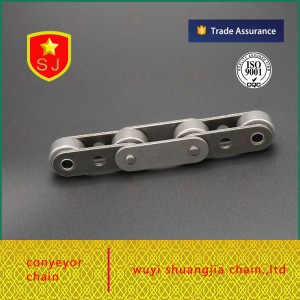In terms of power transmission, different types of chains are used to transmit mechanical power from one place to another. Two common types of chains used in these applications are sleeve chains and roller chains. Although they may look similar at first glance, there are some noticeable differences between the two.
In this blog post, we’ll explore the differences between sleeve and roller chains, their respective applications, and the advantages and disadvantages of each type.
What is a bush chain?
A sleeve chain, also known as a flat chain, is a simple chain consisting of interconnecting plates connected by a cylindrical sleeve. These chains are typically used in applications where loads are relatively light and precise alignment is not required.
One of the key features of sleeve chains is their ability to run smoothly on sprockets, making them ideal for low-speed, low-load applications. Additionally, sleeve chains are simple in construction and easy to maintain and repair, making them a cost-effective solution for many industrial applications.
What is a roller chain?
A roller chain, on the other hand, is a more complex chain that features cylindrical rollers located between inner and outer plates. This design allows for smoother, more efficient operation, especially at higher speeds and heavier loads.
Roller chains are widely used in industrial and automotive applications where precision and durability are critical. They are commonly used in conveyor systems, motorcycles, bicycles and other power transmission applications where reliability and smooth operation are critical.
The difference between sleeve chain and roller chain
1. Construction:
The most significant difference between sleeve chains and roller chains is their construction. Bushing chains consist of interconnecting plates and cylindrical bushings, while roller chains use rollers for smoother, more efficient operation.
2. Load capacity:
Roller chains are better suited for heavier loads and higher speeds than sleeve chains. Adding rollers to a roller chain distributes load more evenly, reduces wear and extends the overall life of the chain.
3. Accuracy and alignment:
Due to the presence of rollers, roller chains provide better accuracy and alignment compared to sleeve chains. This makes them ideal for applications requiring precise power transmission, such as automotive and industrial machinery.
4. Application:
Sleeve chains are typically used in low-speed, low-load applications such as agricultural equipment, while roller chains are ideal for high-speed, heavy-load applications, including conveyor systems and power transmission in manufacturing plants.
The advantages and disadvantages of
Bush chain:
advantage:
- Simple and cost-effective construction
- Easy to maintain and repair
- Suitable for light duty applications
shortcoming:
- Limited load capacity and speed capabilities
- Less precision and accuracy compared to roller chains
Roller chain:
advantage:
- Higher load capacity and speed capability
- Better accuracy and alignment
- Longer service life and less wear and tear
shortcoming:
- More complex structure and higher cost
- Requires more maintenance and care than sleeve chain
In conclusion, both sleeve and roller chains have their own unique advantages and disadvantages, making them suitable for different types of power transmission applications. When choosing between the two, it is critical to consider the specific requirements of the application, including load capacity, speed, accuracy and maintenance needs.
Ultimately, understanding the differences between sleeve and roller chains will help select the most appropriate option for a given application, ensuring efficient and reliable power transmission. Whether you are working with light machinery or heavy industrial equipment, the choice between sleeve chain and roller chain can have a significant impact on the performance and life of your power transmission system.
Post time: Mar-01-2024

